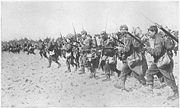
Attaque à outrance
Encyclopedia

World War I
World War I , which was predominantly called the World War or the Great War from its occurrence until 1939, and the First World War or World War I thereafter, was a major war centred in Europe that began on 28 July 1914 and lasted until 11 November 1918...
.
This philosophy was a response to the increasing weight of defensive firepower that accrued to armies in the nineteenth century, as a result of several technological innovations, notably breech-loading rifled guns, machine guns, and light field artillery firing high-explosive shells. It held that the victor would be the side with the strongest will, courage, and dash (élan), and that every attack must therefore be pushed to the limit. The invention of machine gun
Machine gun
A machine gun is a fully automatic mounted or portable firearm, usually designed to fire rounds in quick succession from an ammunition belt or large-capacity magazine, typically at a rate of several hundred rounds per minute....
s and barbed wire
Barbed wire
Barbed wire, also known as barb wire , is a type of fencing wire constructed with sharp edges or points arranged at intervals along the strand. It is used to construct inexpensive fences and is used atop walls surrounding secured property...
as well as the subsequent development of trench warfare
Trench warfare
Trench warfare is a form of occupied fighting lines, consisting largely of trenches, in which troops are largely immune to the enemy's small arms fire and are substantially sheltered from artillery...
rendered this tactic extremely costly and usually ineffective.
The philosophy is particularly associated with the French, due to its adoption by Noël de Castelnau
Noël Édouard, vicomte de Curières de Castelnau
Noël Marie Joseph Édouard, Vicomte de Curières de Castelnau was a French general in World War I, one of the leading proponents of the philosophy of attaque à outrance that dominated French military thinking in the early part of the war.Born in Gascony to a family with a long history of military...
in the First Battle of Champagne
First Battle of Champagne
The First Battle of Champagne was fought early in World War I in the Champagne region of France, between the French and German Empire armies. It was effectively the first significant attack by the Allies against the Germans since the construction of trenches following the so-called 'Race to the...
(1914), and by Robert Nivelle
Robert Nivelle
Robert Georges Nivelle was a French artillery officer who served in the Boxer Rebellion, and the First World War. In May 1916, he was given command of the French Third Army in the Battle of Verdun, leading counter-offensives that rolled back the German forces in late 1916...
in the Nivelle Offensive
Nivelle offensive
The Nivelle Offensive was a 1917 French attack on the Western Front in the First World War. Promised as the assault that would end the war within 48 hours, with casualties expected of around 10,000 men, it failed on both counts. It was a three-stage plan:...
(1917). Joseph Joffre
Joseph Joffre
Joseph Jacques Césaire Joffre OM was a French general during World War I. He is most known for regrouping the retreating allied armies to defeat the Germans at the strategically decisive First Battle of the Marne in 1914. His popularity led to his nickname Papa Joffre.-Biography:Joffre was born in...
, French chief of general staff from 1911 on, had originally adopted the doctrine for the French military and purged the army of 'defensively-minded' commanders. However, all sides launched large, costly and futile frontal offensives in this style: the British at the Battle of the Somme (1916)
Battle of the Somme (1916)
The Battle of the Somme , also known as the Somme Offensive, took place during the First World War between 1 July and 14 November 1916 in the Somme department of France, on both banks of the river of the same name...
, the Germans in the First Battle of Ypres
First Battle of Ypres
The First Battle of Ypres, also called the First Battle of Flanders , was a First World War battle fought for the strategic town of Ypres in western Belgium...
(1914), the Russians in the Brusilov Offensive
Brusilov Offensive
The Brusilov Offensive , also known as the June Advance, was the Russian Empire's greatest feat of arms during World War I, and among the most lethal battles in world history. Prof. Graydon A. Tunstall of the University of South Florida called the Brusilov Offensive of 1916 the worst crisis of...
(1916), and so on.
The origins of this doctrine are traced back to the increasingly militarized 'Warrior Culture' that most European nations developed during the 19th century, where the ideal citizen was the soldier in the employ of his homeland. This predisposed officers and soldiers towards narrow ideals focusing on blind courage in the face of war's adversity.

